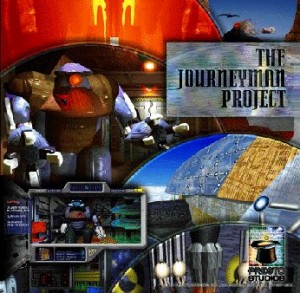Review for The Journeyman Project Turbo
Pack a lunch, grab a sweater, and buckle up, adventure fans. We’re going time travelling, courtesy of Presto Studios.
Flash forward: Year 2308
Mankind is finally at peace after pushing itself to the brink of destruction. This worldwide harmony has allowed growth, research, and exploration on an unprecedented scale. With cities in the sky and colonies on other planets, Earth is visited by an alien race called the Cyrollans, who extend an offer to join an alliance called the Symbiotry of Peaceful Beings. As this is such a significant decision, they leave with the promise to return for our answer in ten years.
In the ensuing decade, the mystery of time itself is overcome, and the world's first time travel machine is built. Although created with noble intent, the potential to abuse time travel for destructive purposes is recognized, so an elite protection unit is created to safeguard history. Never has this been more important than on the day of the Cyrollans' return, as the key to the future lies in securing the past.
Dial back: Year 1992
Before there was Myst (so don’t call it a clone), a rookie team of developers seeks to create "The World's First Photorealistic Adventure Game!" based on the premise above, and The Journeyman Project is born...
Okay, so I'm mixing not only past and future, but fantasy and reality. It's hard to avoid, though, as playing this futuristic sci-fi adventure today involves an understanding and acceptance of its historical development. So many things we take for granted in today's adventures were still in their infancy at that time. It'd be easy to write the game off now for its obvious limitations, but not only was this game pushing boundaries in its day, it went on to spawn two sequels to form a trilogy that has become something of a cult classic.
You won’t need to brush up on your Einstein or Hawking to follow Presto’s tale. If you've ever read the likes of Bradbury, Asimov, or Wells, you'll find no surprises in The Journeyman Project. Heck, even watching Star Trek, Back to the Future, or Terminator would serve just as well as an introduction to time travel. Chances are, everyone's had enough exposure to the space-time continuum, paradoxes, and temporal rips to feel at ease here.
The Journeyman Project is a first-person, node movement adventure that puts the player in control of Agent 5 of the Temporal Security Annex (TSA), the force assigned to protect Earth's past. As the game begins, the Cyrollan delegate is due to arrive for Earth's acceptance to their earlier invitation. Not everyone agrees with the decision, however, and no sooner have you leisurely familiarized yourself with the gameplay mechanics and reported Agent 5 to work, than crisis hits. Somehow, a dissenter has found a way to distort history in three different time periods, each of which will prevent the Cyrollans from ever extending the offer. It's Agent 5’s job, therefore, to travel back in time (though still in OUR future), prevent the distortions before they occur, and return to eliminate the source of the threat.
The first thing you'll invariably notice about the game is its tiny viewscreen. Being generous, it covers no more than a third of the screen. In fact, the complex interface takes up almost the same amount of room. This interface, which is explained as a projection from a TSA eye monocle, contains the inventory, information windows, movement icons, and special biotech chips which need to be collected and utilized throughout the game. While this may seem cumbersome and unintuitive at first, it's actually quite stylish, and the game even provides a narrated interface overview from the main menu. Unfortunately, the one feature that definitely should have been streamlined is the save and restore menu, which you'll wind up using fairly often; more on that in a moment.
The graphics themselves are no eye candy, but no eyesore, either. Presented in fixed 640x480 resolution with 256 colours, they fall significantly short of being photorealistic, but are nicely rendered, and still adequate despite their age. The hi-tech environments are fairly simple, but serviceable. Various animations help to bring the gameworld alive somewhat, but it's still a lonely journey. You won't meet any people in your travels, outside of pre-recorded video clips, so your only company will be periodic robot encounters. One of the game's strengths, however, is its degree of interactivity. Whether it's holograms you can switch on and off, or redundant elevator buttons with programmed responses, The Journeyman Project invites you to explore along the way, and rewards you for experimenting.
The game's sound is consistent with the rest of the production values. Sound effects are basic, but liberally used and effective, and the voice acting serves the plot well. The music is interspersed nicely, with dramatic moments marked by more up-tempo instrumentals, although I found some a little overbearing at times.
As for the gameplay, The Journeyman Project's puzzles are definitely on the easy side. There really aren't many of them to begin with, and those presented shouldn't prove any kind of substantial challenge to veteran adventure gamers. Even newbies should have little difficulty with the pattern matching and other simple logic or inventory puzzles offered here. It's clear that Presto refused to implement random puzzles to artificially increase the difficulty, focusing instead on integrated obstacles that serve the story.
The greater challenge in the game is posed by the inherent dangers. It's possible to die or fail in The Journeyman Project, and you'll undoubtedly do plenty of both, either due to awkward controls or timed sequences. The control issue doesn’t apply to standard navigation, fortunately, but does crop up in specific instances. There are activities that can’t quite be called "arcade", but may pose similar difficulties. One puzzle stands out as being particularly finicky, as it requires repeated manipulation of an uncooperative trackball on an in-game computer (yes, control within control issues!) while the clock ticks down. Other timed sequences are liable to end your day early, as well, so follow the time-honoured tradition of “save early, save often.”
Each mission provides only a limited amount of time to complete the goals, but most people will find the allotment to be more than sufficient. The environments are small enough that there won't be much wasted time to slow your progress. In addition, you can hit the "recall" button at any stage, and when you return, your time will be reset. The only thing this affects is the game's point system, which is a curiosity but completely irrelevant, as there isn't a maximum point total that provides a standard to gauge your progress.
Worse than any timing annoyance is the possibility of hitting a dead end that only reveals itself late in the game. Trust me; I hit it. There is one biochip absolutely necessary to bypass an obstacle, and the game will deny you the opportunity to collect it if you remove another out of order, but let you blissfully continue with no hint of trouble to come. This is completely inconsistent with the many "failed mission" screens you can experience elsewhere, so it's all the more surprising to find such a glaring contradiction. I only found the one example, but that was more than enough.
Aside from that frustration, the game is completely stable. The "Turbo" version of the game is a technical upgrade which eliminates some lag in the original release. The game can be run directly from the CD, or off a small installation. I tried it both ways, and experienced no glitches at all. With all the problems generally related to backwards compatibility, this was a welcome change.
Progression through the game offers a certain degree of freedom in the early going, but becomes more linear towards its conclusion. At each destination, there is both a peaceful and aggressive method for achieving your goals. These options provide only cosmetic (and point-scoring) differences, though, as the game plays out identically no matter what approach you choose. Still, offering the choice is a smart addition that reflects Presto's dedication to providing a more immersive playing experience. If only this commitment also applied to the game's ending, which consists of nothing more than an abrupt splash screen that can only be described as a letdown (in terms of form, not content).
Time flies when you're having fun, and that's certainly true in this game, as The Journeyman Project is over all too soon. Even accounting for the numerous inevitable reloads, I can't imagine the game taking anyone more than 5 hours at most, and for some it will be significantly less. This fact would definitely have impacted an evaluation of a new game sold for top dollar, but as this one can be picked up for a song these days, value shouldn't be a issue. Just be sure to set your expectations accordingly.
Is The Journeyman Project worth playing? Well, if you're looking for a standalone science-fiction adventure to lose yourself in for hours on end, take a pass. If you're considering the entire Journeyman trilogy, however, then I highly recommend you do play the first. Not only does its story lay the foundation for the sequels, but it's an entertaining little diversion in its own right. Sure, it's clichéd, and more of an antiquated interactive multimedia experience than a narrative-rich puzzle game, but for all the time it'll take to complete, it's certainly worth the investment.































